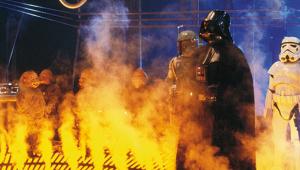Transforming home cinema audio

By the end of the year, nearly all the key AV receiver manufacturers will have models compatible with the new Dolby Atmos 3D audio format. Atmos differs from conventional surround in that it features a height component and 'object-tracking' skills.
The format is making big headway in Hollywood, with more than 200 Atmos movies already produced. Yet worldwide theatrical adoption of the sound system has been relatively slow, as the format waits for expensive refurbishment windows to roll around. All of which makes an Atmos-enabled AVR upgrade all the more attractive.
Of course, these are early days for home media, with only one Blu-ray available at the time of writing – Michael Bay’s metallic clank-fest Transformers: Age of Extinction. Frustratingly, many of the home theatre must-haves now coming to disc boasted Atmos theatrically but are missing it on Blu-ray: Godzilla, Guardians of the Galaxy, X-Men: Days of Future Past – all fan favourite films now lacking Atmosphere, thanks to the vice-like grip of DTS-HD MA.
The Transformers: Age of Extinction Atmos soundmix was created by Academy Award nominee Greg Russell. He describes ...Age of Extinction as the 'perfect film for Dolby Atmos.' So what can we learn from this debut release? Just what benefit does Atmos bring to the home and realistically how does it compare to the established Dolby TrueHD 7.1, when compared blow-for-blow on a seven-channel AVR?

Whatever your view of the value of Bay’s Transformers oeuvre there’s no doubt that …Age of Extinction is technically a standout Blu-ray and a uniquely entertaining system tester. A direct scene-for-scene comparison between the TrueHD 7.1 mix, which utilises both surround back and rear back channels, and Atmos in a 5.1.2 configuration, reveals some intriguing differences, not all of them in the new format’s favour. And, of course, there’s much that sounds the same between the two.
The first scene takes us back to an alien invasion of Earth many years ago. A small beaky beast is about to have his squawks overshadowed by a much larger dinosaur, whose roar is heard surround-right before rolling to surround-left. Seconds later, we’re facing a stampede of CGI-osaurs.
In both mixes, the sound placement is the same, with the final rush very L/C/R weighted. Curiously, the LFE seems more pronounced in the Atmos mix, although the sound pressure level between the two tracks measures nigh-on identical.
This sequence is immediately followed by a classic back-to-front fly-in as a plane heads down to an Arctic base. Perhaps surprisingly, the effect is a good deal less impressive in Atmos than it is in straight seven-channel. Instead of zooming in from behind the listening position, the plane magically appears in the surround-right speaker. As a result, the seven-channel mix seems larger and more expansive.
When we’re introduced to Mark Wahlberg's Cade Yeager character, he’s rummaging around an old movie theatre. Japing around, he throws a football to his slacker chum, played by T.J. Miller, hitting him square on the head. Miller tries to return the ball.
In the seven-channel mix, the ball bounces high front-right and lands in the rear-back channel, but in the Atmos iteration, the ball’s trajectory is completely different. After hitting offstage front-right, it appears to fly higher and return to the screen from the rear right of the soundfield. Sonically this corresponds much better with the onscreen visual of the returning ball. The overall imaging is more believable.

A key sound sequence occurs at the end of the movie (Chapter 20 of the Blu-ray), when Longshot’s massive spaceship uses a giant magnet (obviously) to suck up all the metal content it can find, including ships, cars and the odd Autobot from Hong Kong harbour. The effect makes a particular virtue of the height speakers when it plays theatrically, with pulsating oscillating tones that move from the side walls up into the centre of the cinema, to give an almost bewildering sense of vertical movement.
When the magnetic pulse from the mega magnet is unleashed in 7.1, it sits fixed in both the front and rear channels, and doesn't appear to budge. Indeed, the first time you actually hear this fluttering effect at volume, you’ll most likely fear for your loudspeaker drivers. What then follows is a shower of ships, propellers and assorted debris. Sound effects blanket the soundstage, and it's undeniably impressive – but there’s no sense of movement.
The sequence is punctuated when a tidal wave crashes in from the rear, as our Autobot heroes fall back. When the Star Ferry drops, there's an impressive, tangible, thump. The ensuing melee is a wonderful cacophony of aural effects, with copious clanks and LFE rumbles.
Switch to Atmos and the sequence sounds radically different. Longshot’s magnetic space weapon audibly appears to be syphoning metal upward into a black hole in the ceiling. There's also far less of the disturbing speaker-flapping heard in the 7.1 mix, replaced instead by a more believable sonic vortex. It’s a terrific piece of audio design.
However, yet again there are swings and roundabouts. When the heavy machinery falls back to Earth, and that propeller bounces over Mark Wahlberg's car, the debris field sounds somehow smaller. Taken as a whole, the sequence is more ingenious in Dolby Atmos, but is it actually more entertaining? Not necessarily.
Of course, there are plenty of standout moments in the Atmos mix that occur so quickly you may not notice them – it’s all part of being caught up in the AV spectacle. At 2:26:41 on the disc, we get 'I'm proud of you!' followed by a flyover of a spacejet, which we quickly see is chasing Bumblebee riding a two-headed Dinobot (don't ask). The effect is locked to the rear but has a sensational sense of height as it moves over your head. You’ll grin broadly.

So what can we deduce from this Atmos debut? Perhaps most importantly, the format brings something new and different to the home cinema listening experience. Used creatively, it conjures up a sonic environment unlike any we’ve heard in the home before, despite multiple attempts by post-processing codecs like Audyssey DSX. But conversely, Atmos doesn’t render 7.1 redundant, and in several cases the latter mix can actually sound better!
For enthusiasts this is a win-win situation. Upgraders can configure their new AVR however they want, opting for Atmos as and when. And buying an AVR now that doesn’t offer an Atmos upgrade path is a far more perilous choice. Caveat emptor, as Optimus Prime would no doubt sagely say.
 |
Home Cinema Choice #351 is on sale now, featuring: Samsung S95D flagship OLED TV; Ascendo loudspeakers; Pioneer VSA-LX805 AV receiver; UST projector roundup; 2024’s summer movies; Conan 4K; and more
|























































